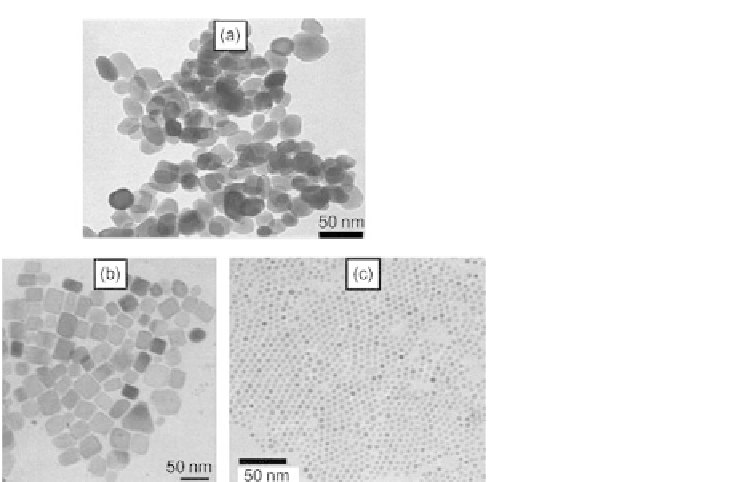Geoscience Reference
In-Depth Information
Figure 10.33. TEM images
of iron oxide nanoparticles
synthesized under
supercritical hydrothermal
conditions (400
C and
30 MPa) without and with
organic ligand molecules: (a)
without modifier (hematite),
(b) modified with decanoic
acid (magnetite), and (c)
modified with oleic acid
(magnetite).
Source: From the works of
T. Adschiri, Tohoku, univ,
Sendai, Japan.
to improve mixing inside the reactor. A diagram of their reactor is shown in
Figure 10.34
. Supercritical water is introduced into the reactor from the top and the
precursor metal salt stream from the bottom. Mixing of the two streams is almost
instantaneous and makes use of buoyancy-induced eddies to produce “ideal” mix-
ing conditions. This leads to very low residence times and limits subsequent parti-
cle growth. Lester et al. synthesized many metal oxides in the size range of
6
64 nm in their system, thereby demonstrating the effective separation of nucle-
ation and growth steps in continuous hydrothermal processing. The continuous
hydrothermal technique offers many opportunities for controlling particle size and
morphology by keeping residence times low and mixing processes efficient. It is
also easy to scale up. However, the engineering of particle surfaces cannot be
accomplished in situ and requires additional postprocessing steps.
A major challenge for all methods is the design of magnetic nanoparticles with
effective surface coatings that provide optimum performance in vitro and in vivo
biological applications. Additional challenges include scale-up, toxicity, and safety
of large-scale particle production processes.
Recently, considerable attention has been focused on low-dimensional nanoma-
terials owing to their unique physical properties and potential applications in
sensors, magnetic, electric transportation, optics, and even as building blocks for
nanoscale devices. In this regard, the hydrothermal method has become more popu-
lar for the synthesis of low-dimensional nanoarchitectures of several metal oxides
like titania, zinc oxide, and iron oxide in the form of nanotubes, nanorods, nano-
wires, nanoribbons, and nanofilms. Yao and Yu
[152]
have reviewed the hydrother-
mal
synthesis low-dimensional nanoarchitectures. However, the rationale for the
hydrothermal synthesis of such nanomaterials with specific nanostructures is still in

